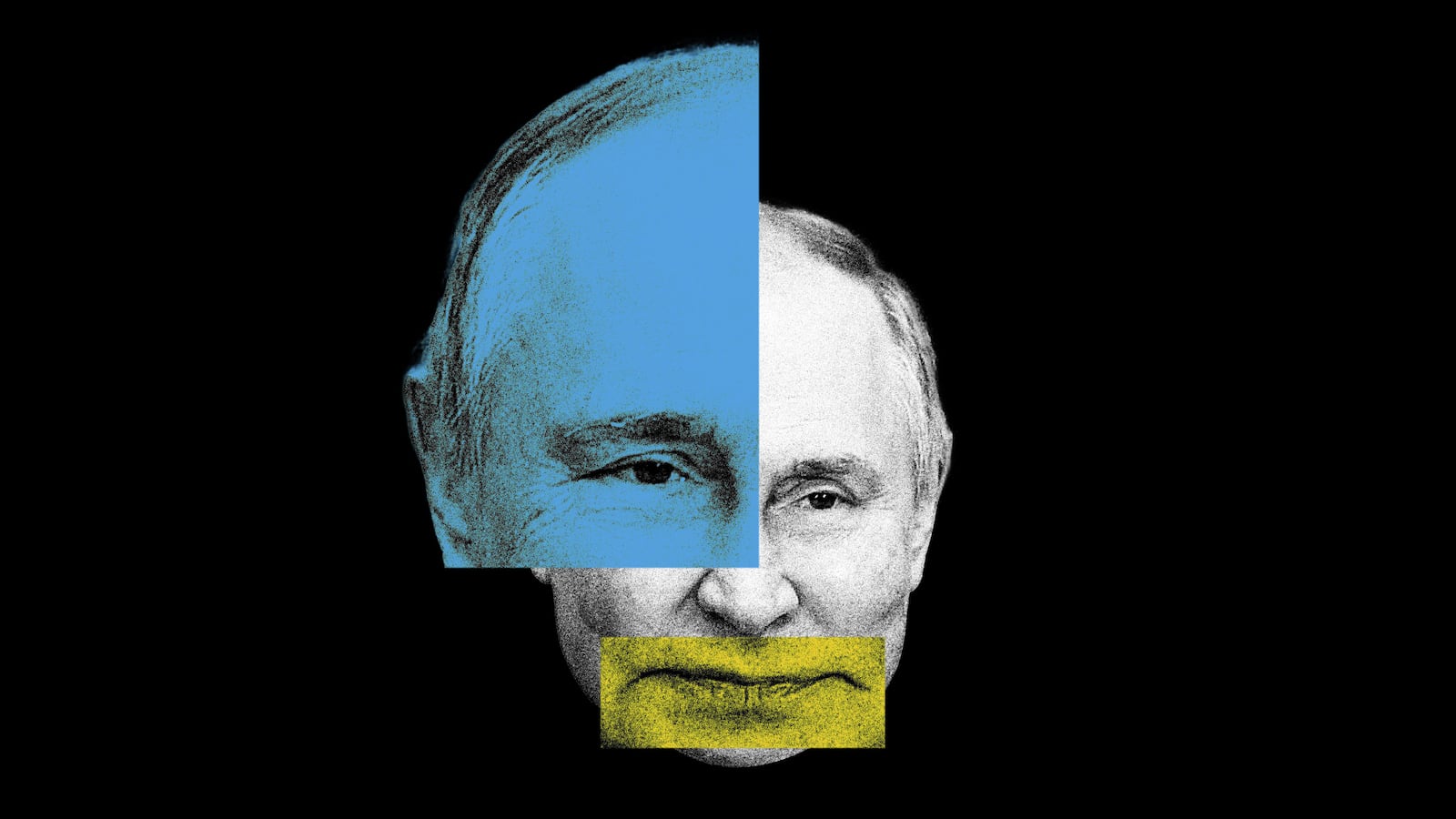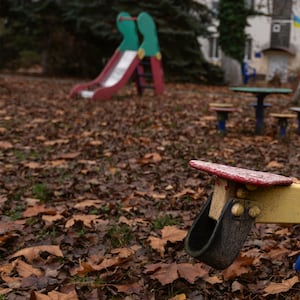KYIV—Ukrainian surgeons are performing a strenuous new wartime medical procedure: providing facial reconstruction surgery for people injured in Russian attacks.
They are teaching themselves to perform medical services they never expected to do, racing against time to decide what can and cannot be saved, working through screams from patients and air raid sirens, and struggling to afford critically needed supplies. One miscalculation might cause irreversible damage.
“We never expected such a war to happen,” Valeriy Bovkun, the Head of the Department of Reconstructive Plastic Microsurgery at the Okhmatdyt Children’s Hospital, told The Daily Beast. But the duration of Vladimir Putin’s war is felt with every child who arrives at the hospital.
The hospital once performed just two or three facial reconstruction surgeries a year, most arising from car crashes or firework injuries. Now, their work includes removing a piece of shrapnel the size of a pencil from a 13-year-old boy’s leg, or stitching a child’s face back together to repair damage caused by missile shelling. The doctors here have become wartime medics for under 18s.
Over the past year, Russia’s invasion of Ukraine has impacted all of the country’s more than 43 million inhabitants. The war has caused more than 8 million Ukrainians to flee their homes, and according to the United Nations Human Rights Chief, Volker Türk, at least 21,000 civilian casualties, leaving 8,006 dead and 13,287 injured. At least 487 children have been killed and 954 injured since the war began.
The injuries to children were seen daily by the surgeons at the Okhmatdyt Hospital, and at the beginning, the staff was so overwhelmed that in March, they were “living [at] work, there was no fear, but of course, we were very worried. There was uncertainty because the patients who were coming were not our typical patients. We had to learn on the go,” said Bovkun.
Help came to the hospital when Doctors Without Borders arrived. “They teach us how to deal with the traumas because it was also very difficult for patients, plus additionally the [staff] needed to ensure safety,” said Bovkun.
Gradually, the surgeons became more accustomed to the work. Still, there were other things they could not prepare for, like when Russian troops opened fire outside the hospital. No one was injured in the attacks because they were hiding in the basement, but the bullet holes in the hospital’s exterior can still be seen today, and the work the war brings is unrelenting.
Trauma from the outside in
“When a child has a congenital defect from birth, the doctors are ready, the parents are ready, but in such situations where a completely healthy child becomes a child with a disability because of all the trauma, emotionally it is very hard,” Bovkun said.
Bovkun unlocked his phone to show images of some of the children he has performed surgeries on over the past year. As he scrolls, reciting courses of treatment, he pauses at an image of a 10-year-old girl whose left cheek was torn during a shrapnel attack. Bovkun performed a skin graft on her neck to cover some of the scarring. He reveals other images of wounds to children, including the loss of limbs, scarring, and X-rays of bullets lodged in children’s knees and hands.
“The older kids, they understand everything. It is very difficult for them because they feel their features are ruined after the trauma; psychologists help them to change their way of thinking that everything is still ahead and bright features are still ahead. And for younger kids, they don’t realize it, and they behave like it was usual trauma,” said Bovkun.
On Jan. 23, the hospital admitted a 6-year-old girl from Kherson, the eastern city that was liberated in November but remained a hotspot for Russian attacks. A few weeks before her arrival, the child was playing in her bedroom when a missile landed on her apartment, injuring her. In a picture on Bovkun’s phone, the girl sits propped up in a hospital bed, her long orange curls catching the light. Large scabs that match the color of her hair cover her face, and her left eye is wrapped in gauze—the hospital could not save it. Though the injuries had happened just days before, the girl was smiling for the camera, her hands wrapped in gauze, holding a plush white rabbit with an Easter egg on its stomach.
“She’s doing great, psychologists are supporting her, and she’s also brave. We, as doctors, don’t think about the injuries a child receives. We are thinking about how we can help the child to save the wound, the life, and this also helps us because we are helping the child in this hospital,” said Bovkun. “Emotionally, when you see the kids with such injuries, you feel hate for those people who did it specifically, and you also feel compassion for the small patients who go through this.”
A 20-minute drive from Okhmatdyt Hospital, at Anacostia Clinic, a Border Control worker named Ruslan is undergoing a round of scar removal treatment following a shrapnel injury he received at the beginning of the war. He was in a building in Kharkiv when Russian forces struck it with a Kalibr Missile, killing three of his colleagues. The impact of the attack caused Ruslan to lose consciousness, but when he came to, he felt a large piece of shrapnel lodged in the right side of his face. After ripping the metal from his skin, Ruslan saw that first aid services were already arriving at the location. “Everything was in blood. There were already people coming with first aid. They said, ‘Show me your face—oh my god.’”
In the following days, Ruslan was taken to a military hospital for further treatment to ensure that the wounds healed properly. But the overwhelmed medical staff did not have time to stitch his face together in a way that would minimize the scarring.
Besides the scar, the injury that caused Ruslan to sink into depression was losing all but 1 percent of the sight in his right eye. It took six surgeries for the doctors to remove all of the shrapnel. Even then, they were unsure if he would ever be able to see out if it again. But it was when Ruslan’s wife found the non-governmental organization, No Scar, that he began to pull himself out of his depression. As Ruslan spoke, he joked with about how his wife wanted him to be attractive again, which is what led her to finding the NGO.
No Scar is a network of more than 40 plastic surgeons who offer their services free to some of the many who need scar removal treatment due to wartime injuries. The treatment begins in the months following facial reconstruction surgeries and stitches removal, and involves non-invasive techniques of removing layers of scar tissue that haven’t healed. With No Scar, Ruslan has been able to regain a slight amount of the sight in his right eye. The right side of his face is also on track to heal, but with months to go.
Referring to the work of past surgeons, Yullia Demtsova, No Scar’s founder, told The Daily Beast that patients often “do not consider that the appearance affects the mental state, and of course, if the person is constantly thinking of scar and regards a scar as a disability, it has a very negative impact on the healing overall and his perception and the quality of life overall.”
“I believe plastic surgery in this regard is as important as any other surgery. It’s not a person being too picky, [because] it really does impact [their] overall self-esteem,” she adds.
‘For myself’
Walking down the street, people with deformities and scars stand out from the crowd. For military nurse Olya Osadcha, each passing glance from onlookers—a mixture of pity and fascination—brings about a flood of insecurity.
Osadcha was stationed in Donetsk when her life was changed forever after a Russian attack. At the time, she was treating a soldier in the back of a medical van along with an assistant. A driver was sitting at the steering wheel, transporting the four to the nearest military hospital. “The closest enemy was 700 meters away from the vehicle… and [the van] fired upon by a guided anti-military tank weapon,” she said.
“The driver was the first to come to after the explosion. [He] opened the vehicle’s rear doors. I was lying there. He pulled me out of the burning vehicle,” she explained.
After gaining consciousness, Osadcha looked into the van to find the bodies of her assistant and the soldier she was treating, lifeless and on fire. She did not notice her own injuries at first. “There was no pain at the time of the injury,” she said, “most likely due to traumatic shock. Only blood, it flowed heavily, simply flooded my face, from my right shoulder, from my right leg.” Her right shoe filled with so much blood that it slipped off her foot, she recalled.
Osadcha remembers few details of the attack—she said it hit her three days later in a military hospital in Kyiv. “There I was constantly anesthetized, but still, everything hurt a lot,” she said. She remained at the hospital for four and a half months receiving medical treatment, 10 operations, and one month of rehabilitation.
“Now I have a prosthesis on my right eye; of course, I can’t see anything with it. I can only see with my left eye,” Osadcha said. She still has shrapnel residue in her face, which she can feel daily and causes pain. But one of the hardest aspects of coping with the injury is the emotional toll.
“As a woman, I want one thing, to restore the face as much as possible. This is very, very important to me. I want to correct all the defects, first for myself,” she told The Daily Beast. “My relatives support me in everything. They say they love me and I am most beautiful to them, and I know that is so. But for myself, I want to be like before, walk with an open face and not catch sympathetic glances from passersby.”







